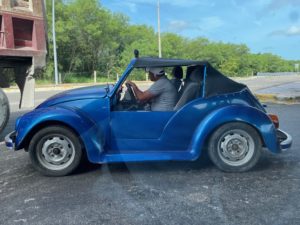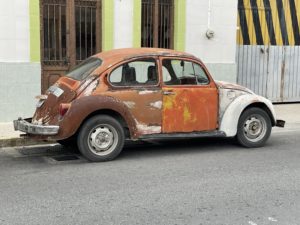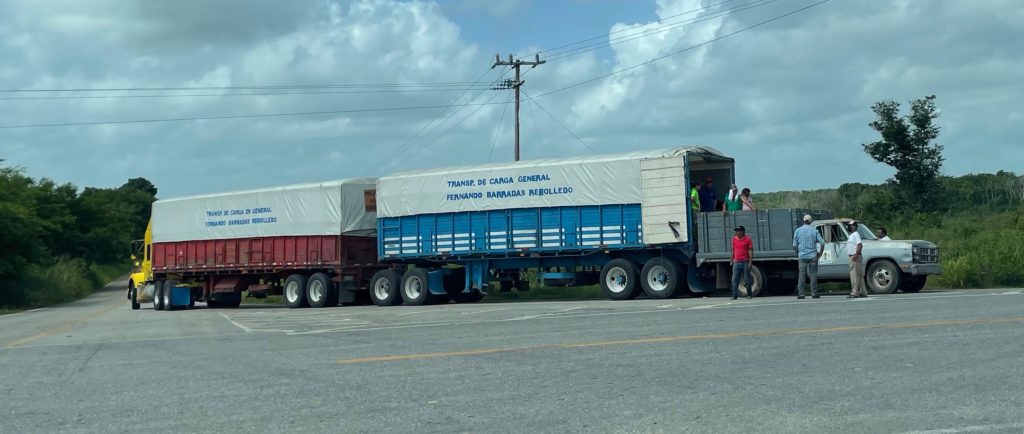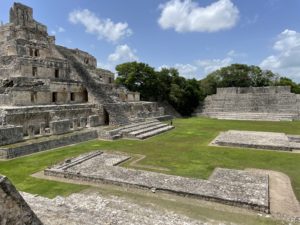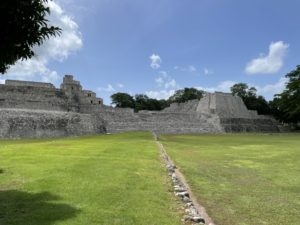In which Sid and Doris visit their second Maya site before a long drive to Merida.
Seven o’clock is the approved hour for a morning run along the prom and Sid joins the crowd, running past the port office and along to the concrete hammerhead where the fishing fleet lives. These boats are about five metres long, made of very solid fibreglass. They take an outboard but to eke out the fuel there are oars and a stick mast and boom for a simple square sail. The lads are already preparing their nets. Sid gives it a gentle fartlek home.
We leave Campeche with the usual contenders for Conveyance of the Day – beetles and road trains.
At Edzna the car park is almost empty. As we walk out of the ticketing zone there is a sign asking tourists not to be accomplices to corruption and to be sure we had taken our tickets. Mysteriously, we had paid but not got our tickets, distracted by the little ‘Where are you from?’ questionnaire. Sid went back to collect them.
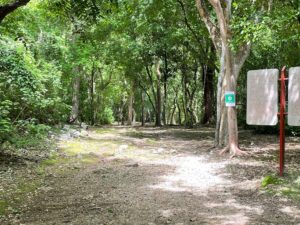 Edzna was an active city from about 600 BC to 1520. It has a fine main square, very much larger than Colonial Spanish Campeche at about 100m by 160m. The place is less busy than Palenque, we take our book as guide and look out the info boards which have an English section. This area has plenty of rain here so there is less emphasis on water engineering. The town was in its pomp from 200 to 1000 AD when it also supported about 25,000 people. The town was deserted by the time the Spanish arrived and it was not re-discovered until 1907. Work to uncover the Central Business District of rulers’ offices, temples, palaces and ball court began in 1958 with another effort in the 1980s. Today it is very quiet though we meet a traveler from Los Angeles using the local buses.
Edzna was an active city from about 600 BC to 1520. It has a fine main square, very much larger than Colonial Spanish Campeche at about 100m by 160m. The place is less busy than Palenque, we take our book as guide and look out the info boards which have an English section. This area has plenty of rain here so there is less emphasis on water engineering. The town was in its pomp from 200 to 1000 AD when it also supported about 25,000 people. The town was deserted by the time the Spanish arrived and it was not re-discovered until 1907. Work to uncover the Central Business District of rulers’ offices, temples, palaces and ball court began in 1958 with another effort in the 1980s. Today it is very quiet though we meet a traveler from Los Angeles using the local buses.
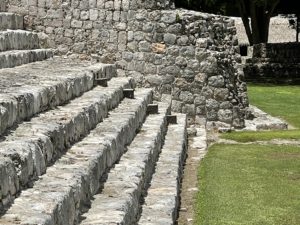
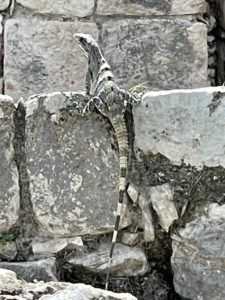 We do the compulsory Climb That Thing activity, aided by some discreetly-placed half-steps and under the disinterested gaze of several iguanas.
We do the compulsory Climb That Thing activity, aided by some discreetly-placed half-steps and under the disinterested gaze of several iguanas.
A somewhat grumpy information board says that “The Maya were never helped by extraterrestrial beings. What they accomplished was due to their ingenuity and hard work. Nor did the Maya disappear. They abandoned some cities to found new ones…” This might require some explanation. Erich von Daniken decided that some of the Mayan carvings could be interpreted as spaceships and wrote a book about it, “Astronaut Gods of the Maya“.
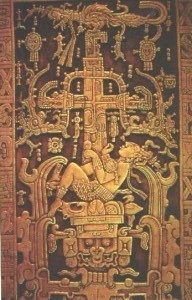 This is the classic picture. Seen this way up it is a man in a tomb, breathing his last and connected to the Mayan tree of life.
This is the classic picture. Seen this way up it is a man in a tomb, breathing his last and connected to the Mayan tree of life.
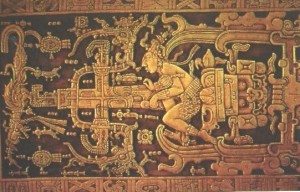 And seen this way up he is sitting on a space rocket. The choice is yours.
And seen this way up he is sitting on a space rocket. The choice is yours.
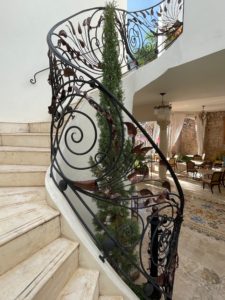
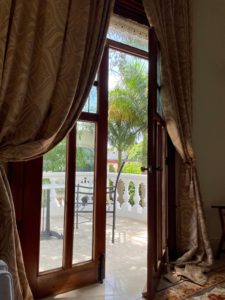 In Merida we are staying at the Secret Palace. It is impressively palatial inside, and in a rather tatty backstreet that makes it so improbable. It is unlikely we will find anywhere more splendid to stay for £60 per head bed and breakfast. It is owned by an Irishman who used to design nightclubs. The detailing is amazing.
In Merida we are staying at the Secret Palace. It is impressively palatial inside, and in a rather tatty backstreet that makes it so improbable. It is unlikely we will find anywhere more splendid to stay for £60 per head bed and breakfast. It is owned by an Irishman who used to design nightclubs. The detailing is amazing.
The town made its fortune from sisal for string and ropes. You may recall our visit to the jute museum in Dundee. Sadly there is no such celebration of sisal which was profitable enough to fund a millionaires’ row of mini palaces along a road the sisal barons had built for the purpose. This was all we saw of the sisal boom. Sisal now mostly comes from Brazil. The industry is much diminished since the advent of cheap blue polyprop that you see everywhere now.
On our way back to the hotel we are caught in a tropical downpour, 20 degrees north here. We walk through the first drops, then seek shelter from the storm. The drops are large, the thunder thunders and the lightning lightens. The roads fill up with water to a depth of several inches. We do more sheltering, and then realise that our journey home is going to involve getting very wet anyway as we have to ford the roads. This happens several times a week; there are no drains. A monsoon every afternoon and an earthquake twice a week.
We have thrown ourselves into the Yucatan experience with a dinner of four regional specialities. We do not shirk our explorers’ duties. Did Sid not order the crunchy insects in Mexico City, admittedly after The Tequila Incident? The four Maya dishes on their lazy Susan would have fed three or four. We have now had enough local cuisine and will look out for typical Italian or Thai menus, as are to be found on all continents probably including Antarctica.
